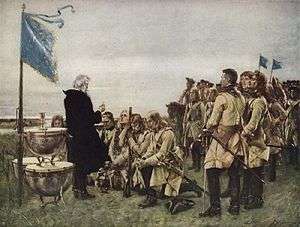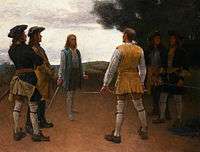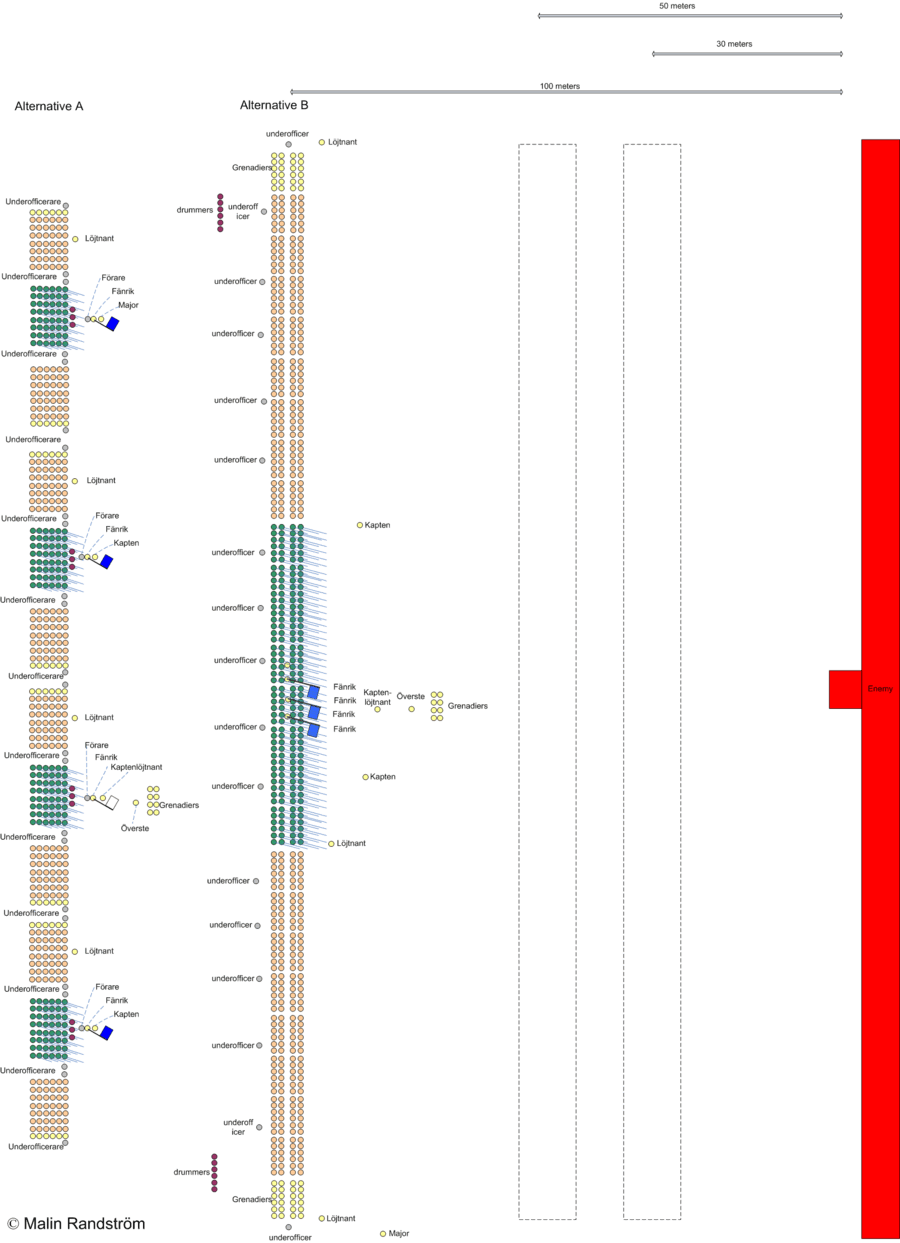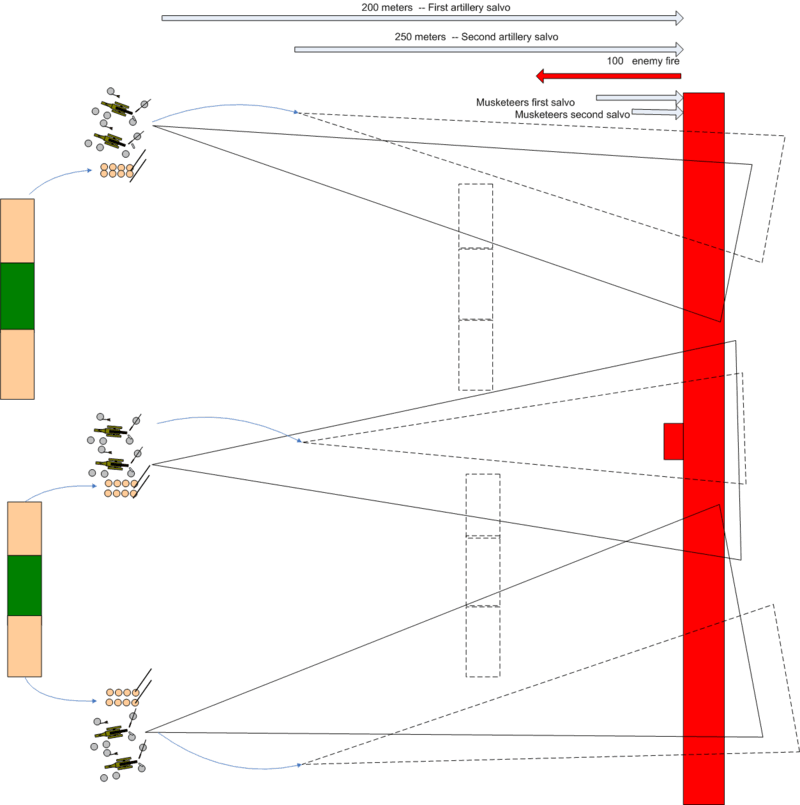Caroleans
Caroleans (Swedish: karoliner) were the soldiers of the Swedish kings Charles XI and Charles XII whose notable tactics differed from that of Western Europe through a greater reliance upon pikes, bayonets, and the spirit of the offensive.
The Carolean army

To compensate for the lack of manpower and resources Sweden strove for innovative ways to make an effective army. The successful path of innovative military ideas was in fact the only way Sweden managed to achieve a great power status. However, having to rely on this to maintain power status was uncertain. The Carolean soldiers were effective soldiers, as shown by their efforts in the Great Northern War, with battles such as Narva, Düna, Klissow, Pultusk, Jakobstadt, Gemauerthof, Warsaw, Fraustadt, Holowczyn, Helsingborg and Gadebusch. Thanks to their achievements during this war, they are regarded to have been perhaps the most effective military troops of that day. The Carolean army was small; because of the sparse number of Swedish soldiers, heavy losses could be irreparable. The Carolean army was defeated after a long and fateful march into the Russian interior, where they were exposed to scorched earth tactics, small frequent raids and the cold Russian climate. The Swedish soldiers who reached the Battle of Poltava were exhausted and hungry. During this long march an estimated 35,000 Swedish soldiers - 70 percent of the army - died of famine, disease and exhaustion. The battle ended with a decisive Russian victory which resulted in the decline of the Swedish Empire.
Morale and Religious Beliefs

Strict discipline was necessary in the Carolean army to allow its very offensive tactics, which among other things exposed soldiers to a medium-distance enemy fire before being allowed to respond. This tactic was intended to get the soldiers close enough to the enemy so that it was almost impossible to miss a shot. The steadfast courage shown from the Swedish troops would also affect enemy morale, at several occasions this would frighten the enemies into retreat.
To attain this steadfast discipline, the army had very strict rules. Even a soldier's private life was strained down by very strict rules, as they were supervised at their soldiers cabin as well as in the field. Religion was used as a tool for keeping the morale high amongst the troops. Not only did the army use religion for military purposes, but regular priests also preached about the virtues of serving the crown and being a soldier to boost enlistment. Within the military, priests often participated in battles to raise morale amongst troops.
In order for soldiers from different regions and provinces of the kingdom to feel companionship and loyalty with fellow soldiers, men from the same region or province were made to stay with each other. The church also helped by creating a feeling of solidarity between soldiers from different parts of the kingdom by showing that the soldiers fought for common beliefs of the Swedish Lutheran church when facing an enemy army. This was also a reminder to the soldiers that God was protective and helped them in battle, as had been said since Sweden fought in the Thirty Years War as the continental leader of Protestantism. After the Battle of Narva many soldiers believed that God had sent them the blizzard that helped them to victory. It was commonly thought that the defeat at Poltava was God's punishment for the soldiers' hubris and sins.
The allotment system

– David Klöcker Ehrenstrahl.
In 1680 Charles XI effected his political and military reforms in parliament whereby he made himself autocrat. His greatest reform was the building of the Allotment system whereby all the farmers in every land was to provide the crown with a full regiment of 1000 men complete with weapons and uniforms. Every land was divided into "Roots"(roots is a poor translation ot the Swedish "rote", more correctly it should be squadron or group). One to 5 farmers would form a Root and sign a contract with the crown that they would provide and support a soldier. In the contract it was stipulated that a soldier would be provided with a cottage and a garden plot.[1] The cavalry was built much the same, the difference being that the Root also provided a horse, this being an extra burden the Root was granted a tax reduction by the crown.[2] In this way Karl XI was ensured a professional army of 18,000 infantry and 8,000 cavalry. There were additional 7,000 infantry and 3,000 cavalry in Finland. Along the coast and major city ports seamen were taken in under the system thus providing the navy with 6,600 seamen in Sweden and 600 in Finland.[3]
It is said about Charles XII that "he could not retreat, only attack or fall". The same goes for his soldiers. In the Swedish army tactics of that time retreat was never covered. Troops were obligated to attack or fight where they stood.
The uniforms
The Carolean uniform was among many variants of the Swedish Standard Uniform introduced by Charles XI. The great coats were blue with yellow cuffs. The breeches were white, and the vest yellow. Many regiments had variations of the uniform, For example, the dragoons of Bohuslän had green coats and the regiment of Närke-Värmland had red cuffs. The artillery had grey coats with blue cuffs. They wore tricorne hats or a special cap called a Karpus. The elite Trabant Garde cavalry were the only armored troops, wearing steel breastplates.
Most of the infantry were equipped with modern flintlock muskets, although older versions still were in use. They were also equipped with rapiers and a bag for ammunition. About one third of each company were equipped with pikes. Twelve men of each company were grenadiers, typically the strongest and tallest men. The grenadiers were also the only soldiers to have bayonets on their muskets. Each company consisted of 150 men. On occasion, two handed spiked clubs were used during sieges. Mounted troops carried broadswords and either two pistols each for the regiment of horse or a carbine for the dragoons. The artillery had a smaller sword for close combat, called hirschfängare.
Organization


– Gustaf Cederström.
The Carolean army was organized into regiments according to region.
- Cavalry regiments, including the Jämtlands dragoon regiment, and the king's personal guards, the Livdrabanterna regiment
- Infantry regiments, including the Värmlands and Västerbottens regiment. Each company had twelve grenadiers
- Artillery regiment
The army also included a special unit called the Livdrabanterna (Royal Life Guard Corps). This was a special unit made up of some 100 men. It was under the personal command of King Charles XII, for which he was named captain. To become a private in the corps one had to attain the rank of Captain in the regular army. The king's second in command was a Colonel with the title of Kaptenlöjtnant (Lieutenant Captain). This corps fought to the bitter end, and some of its veterans carried Charles XII's coffin on its arrival to the capital for the burial in 1719.
Out in field
The rules were strict for the Carolean soldier. For example, stealing food from another soldier would lead to harsh punishment. Looting, as often earlier had been a part of the soldiers' every day was forbidden; however, it occasionally occurred if it was necessary, for example a couple of occasions at Narva and Lemberg.
To take God's name in vain was amongst the worst crime a Carolean soldier could commit, and the punishment for this was death, since it was very important to keep the morale high amongst the troops, and the Christian religion was a way to do this. To interrupt a moment of prayer would as well lead to death penalty. The Carolean soldier was told not to fear, since if God meant him to die, he would die no matter if he dodged the bullets or not. The Carolean offensive tactics needed firm discipline.
A soldier's daily ration should consist of 625 grams of dry bread, 850 grams of butter or pork, 1/3 liters of peas and 2.5 liters of beer. The butter or pork was often replaced by fish if available[4] Water was best avoided since it was often contaminated.
Tactics and formations

A) company wise B) battalion wise.

The Swedish infantry regiment consisted of roughly 1,200 men, divided into two battalions of 600 men each. The battalion was the smallest tactical unit of the Swedish army and consisted of four companies of 150 men each. Prior to battle the men were usually formed into four ranks (four man deep), however, a battalion could also be späckad with six ranks.[5] About one third of the men were pikemen, equipped with 5,55 meter long pikes and swords, these pikemen often made divisions in the middle of each battalion with musketeers to their flanks, however, if the battalion was späckad the pikemen were placed in the third and fourth ranks. Further more, grenadiers were often attached to the flanks of the musketeers—or by the utter far left and right of each battalion—to protect against enemy cavalry and toss grenades to break enemy formations (there was one grenadier for ten musketeers).[6] On occasion, the grenadiers formed own battalions as the Life Grenadier Regiment. The width of a battalion was roughly 180 meters (or 135 meters when the battalion closed gaps). During the outbreak of the Great Northern War every Swedish musketeer was equipped with a sword and often a flintlock musket with a 20 mm caliber, no bayonet attached, the bayonet was instead introduced to every Swedish musketeer first 1704. However, the grenadiers were equipped with grenades, swords and flintlock muskets with bayonet.[7]
The Swedish cavalry regiment consisted of roughly 1,000 men, divided into four squadrons of 250 men each. The squadron was the tactical unit of the Swedish army and consisted of two companies of 125 men each. The Swedish heavy cavalryman was equipped with a rapier (almost one meter long made primary for thrust and secondary for slash), carbine, two pistols and had a cuirass.[8] The dragoons had a rapier, musket with bayonet and two pistols.[9] Certain irregular units were also used, frequently the Vlachs cavalry. However, these were not suited for combat but only reconnaissance and to chase routing enemies.[10] The cavalry was used as the key instrument of victory and made for large proportions in the Swedish army. Contrary to the other regular armies in Europe, the cavalry made up half of the fighting force.[11] For instance, during Charles XII invasion of Russia the army counted 31,000 men, where of more than half, 16,800 men, were cavalry.[12]
Infantry Gå–På
"Never have I seen such a combination of uncontrollable dash and
perfectly controlled discipline, such soldiers and such subjects
are not to be found the wide world over except in Sweden"
General Stenbock, Gadebusch 1712[13]

The Gå–På–method (Literally Go-On) specialized on shock tactics and was the standard combat technique used in the Swedish army at the time. This very aggressive tactic often resulted in short-lived battles in order to counter superior numbers of enemies. According to 1694 and 1701 regulations, the infantry attack operates as follows: In four ranks with gaps, the Swedish battalion would "smooth and slowly" march against enemy fire (which often started at a distance of 100 meters), while making their way to the enemy lines. The Swedish soldiers were first issued to fire when "you could see the whites in the enemies eyes" a range of roughly 50 meters—when the marching drums stopped the two rear ranks would fill the gaps within the two foremost ranks and fire a salvo—and then draw their swords. The two rear ranks would then fall in right behind their previous position and the two foremost would close the gaps after which the battalion would resume their attack. The two foremost ranks then discharged at a range of roughly 20 meters before drawing their swords and the charge began. At this range, the powerful muskets usually felled many enemy troops which was demoralizing to them. Directly after the volley the Swedes charged the enemy ranks with pikes, bayonets and rapiers.[14][15] Note that the pikes were used as an offensive weapon: in close combat they had the advantage over their foes' weapons thanks to their range, it often happened that complete ranks of enemies ran before physical contact, frightened by the long pikes and the fact that the morale of the battalion could calmly withstand their fire.[16]
Modifications through war
This method slightly changed during the course of the Great Northern War, the slow march was replaced with running, the firing distance was reduced to 15 to 20 meters for the first volley of the rear ranks—who would no longer fall into their previous position behind the front ranks, but instead follow in the gaps within and so the battalion attacked in two filled ranks—and then, the foremost ranks would execute the final volley when the soldiers were close enough to effectively perform a bayonet charge.[17] The battalion would also more often during the end get support from artillery pieces, notably in the battle of Gadebusch where a new set of Swedish artillery inventions saw action.[18]
Analysis of method

Either the enemies fired by platoon, rank or all together a common reload was in the end necessary, during this reload—which took in practice 1–2 minutes to finish—an opponent could calmly march 80 meters and run 150 meters (in one minute). This means—with the effective range of roughly 50 meters—that the first line to open fire on 50 meters or above, made for a vulnerable target to the incoming enemy line which marched calmly, steady and fired at a more effective range. The Gå–På–method was based on these simple mathematics.[20]
Cavalry Gå–På
The Swedish cavalry, just as the infantry, fought in this extreme aggressive manner (also called the "Carolingian manner").[6] Prior to battle, contrary to the rest of Europe—which during the time would form up knee to knee—the Swedish cavalry would form up in slight wedge formations in two or three ranks, knee behind knee to successfully achieve the most clustered cavalry formation possible to more fiercely impact the enemies. To achieve this, they had thrust rapiers which would further increase the effectiveness of the charge.[21] The squadron would usually not use any of their pistols during the charge, only blades. In 1704 a regulation was made, disbanding the pistol completely when charging (however, on occasion, the pistols were allowed, which happened in Fraustadt, or when chasing routed enemies). In 1705 another regulation was made, in which the cavalry would ride in trot during the initial phase of the attack and then full-gallop (which was the fastest possible speed) prior to the impact.[21][15]
Coordination between units
Close coordination between infantry, cavalry and sometimes artillery was needed to successfully break down enemy defenses. Only infantry would normally risk a frontal assault on a well prepared line, preferably with artillery assistance. Regimental cannon would keep pace with reloading infantry and protect them against enemy attacks. Cavalry would strike the opponents cavalry, or infantry in disorder, flank or rear. Cavalry was also used to cover an army in retreat or to interfere and chase remaining enemies after a successful infantry attack. If a cavalry attack was repulsed it would fall back behind friendly infantry lines and regroup for another charge. If necessary, the infantry would fall back with alternately fire and movement. In some situations, infantry squares were used for protection against flanking cavalry attacks.[22]
See also
Notes
- ↑ The Allotment Soldier and Root Farmer. Elfred Kumm 1949
- ↑ Karoliner. Alf Åberg & Göte Göransson 1984
- ↑ Karoliner. Alf Åberg & Göte Göransson 1984
- ↑ Åberg, Alf; Göte Göransson (1976). Karoliner. Höganäs: Bra Böcker. pp. 26–27.
- ↑ Konovaltjuk & Lyth, Pavel & Einar (2009). Vägen till Poltava. Slaget vid Lesnaja 1708. Svenskt Militärhistorisk Biblioteks Förlag. p 19.
- 1 2 Lars-Eric Höglund, Åke Sallnäs, The Great Northern War 1700 - 1721 Colours and Uniforms. p 22.
- ↑ Artéus, G Karolinsk och Europeisk stridstaktik 1700-1712, P 29, 30. Exlibria, 1972
- ↑ Fraustadt 1706. Ett fält färgat rött, Sjöström, Oskar, 2008. p. 217, Historiska Media, Lund (Swedish)
- ↑ Konovaltjuk & Lyth, Pavel & Einar (2009). Vägen till Poltava. Slaget vid Lesnaja 1708 (in Swedish). Svenskt Militärhistorisk Biblioteks Förlag. p 19.
- ↑ Konovaltjuk & Lyth, Pavel & Einar (2009). Vägen till Poltava. Slaget vid Lesnaja 1708 (in Swedish). Svenskt Militärhistorisk Biblioteks Förlag. p 117.
- ↑ Fraustadt 1706. Ett fält färgat rött, Sjöström, Oskar, 2008. p. 216, Historiska Media, Lund (Swedish)
- ↑ Konovaltjuk & Lyth, Pavel & Einar (2009). Vägen till Poltava. Slaget vid Lesnaja 1708 (in Swedish). Svenskt Militärhistorisk Biblioteks Förlag. p 19.
- ↑ Charles XII and the Collapse of the Swedish Empire, 1682- 1719 - R. Nisbet Bain. p. 243.
- ↑ Konovaltjuk & Lyth, Pavel & Einar (2009). Vägen till Poltava. Slaget vid Lesnaja 1708. Svenskt Militärhistorisk Biblioteks Förlag. p 244.
- 1 2 Olle Larsson, Stormaktens sista krig (2009) Lund, Historiska Media. p. 68. ISBN 978-91-85873-59-3
- ↑ Fraustadt 1706. Ett fält färgat rött, Sjöström, Oskar, 2008. Historiska Media, Lund (Swedish)
- ↑ Konovaltjuk & Lyth, Pavel & Einar (2009). Vägen till Poltava. Slaget vid Lesnaja 1708 (in Swedish). Svenskt Militärhistorisk Biblioteks Förlag. p 244.
- ↑ Olle Larsson, Stormaktens sista krig (2009) Lund, Historiska Media. p. 250. ISBN 978-91-85873-59-3
- ↑ Fraustadt 1706. Ett fält färgat rött, Sjöström, Oskar, 2008. p. 216, Historiska Media, Lund (Swedish)
- ↑ Konovaltjuk & Lyth, Pavel & Einar (2009). Vägen till Poltava. Slaget vid Lesnaja 1708 (in Swedish). Svenskt Militärhistorisk Biblioteks Förlag. p 244.
- 1 2 Fraustadt 1706. Ett fält färgat rött, Sjöström, Oskar, 2008. p. 217, Historiska Media, Lund (Swedish)
- ↑ Konovaltjuk & Lyth, Pavel & Einar (2009). Vägen till Poltava. Slaget vid Lesnaja 1708 (in Swedish). Svenskt Militärhistorisk Biblioteks Förlag. p 244.